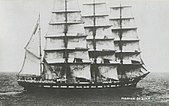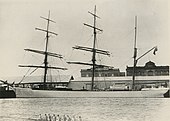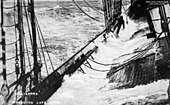
HMS Endeavour was a British Royal Navy research vessel that Lieutenant James Cook commanded to Tahiti, New Zealand and Australia on his first voyage of discovery from 1768 to 1771.

A maritime museum is a museum specializing in the display of objects relating to ships and travel on large bodies of water. A subcategory of maritime museums are naval museums, which focus on navies and the military use of the sea.
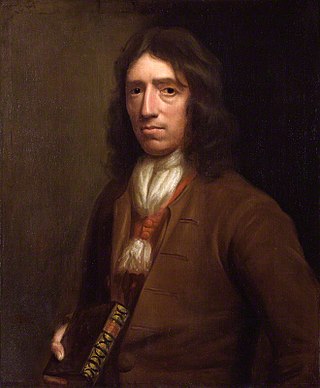
William Dampier was an English explorer, pirate, privateer, navigator, and naturalist who became the first Englishman to explore parts of what is today Australia, and the first person to circumnavigate the world three times. He has also been described as Australia's first natural historian, as well as one of the most important British explorers of the period between Sir Francis Drake and Captain James Cook ; he "bridged those two eras" with a mix of piratical derring-do of the former and scientific inquiry of the latter. His expeditions were among the first to identify and name a number of plants, animals, foods, and cooking techniques for a European audience, being among the first English writers to use words such as avocado, barbecue, and chopsticks. In describing the preparation of avocados, he was the first European to describe the making of guacamole, named the breadfruit plant, and made frequent documentation of the taste of numerous foods foreign to the European palate at the time, such as flamingo and manatee.

Europa is a steel-hulled barque registered in the Netherlands. Originally she was a German lightship, named Senator Brockes and built in 1911 at the H.C. Stülcken & Sohn shipyard in Hamburg, Germany. Until 1977, she was in use by the German Federal Coast Guard as a lightship on the river Elbe. A Dutchman bought the vessel in 1985 and in 1994 she was fully restored as a barque, a three-mast rigged vessel, and retrofitted for special-purpose sail-training.
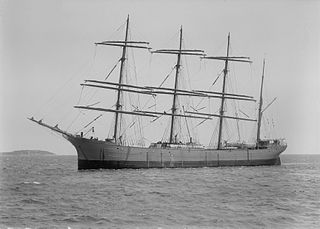
Lawhill was a steel-hulled four-masted barque rigged in "jubilee" or "baldheaded" fashion, i.e. without royal sails over the top-gallant sails, active in the early part of the 20th century. Although her career was not especially remarkable, save perhaps for being consistently profitable as a cargo carrier, in the 1930s Richard Cookson went on board and extensively documented Lawhill's internals and construction, which was later published in the Anatomy of the Ship series.

Balclutha, also known as Star of Alaska, Pacific Queen, or Sailing Ship Balclutha, is a steel-hulled full-rigged ship that was built in 1886. She is representative of several different commercial ventures, including lumber, salmon, and grain. She is a U.S. National Historic Landmark and is currently preserved at the San Francisco Maritime National Historical Park in San Francisco, California. She was added to the National Register of Historic Places on 7 November 1976.

Iron-hulled sailing ships represented the final evolution of sailing ships at the end of the age of sail. They were built to carry bulk cargo for long distances in the nineteenth and early twentieth centuries. They were the largest of merchant sailing ships, with three to five masts and square sails, as well as other sail plans. They carried lumber, guano, grain or ore between continents. Later examples had steel hulls. They are sometimes referred to as "windjammers" or "tall ships". Several survive, variously operating as school ships, museum ships, restaurant ships, and cruise ships.

Suomen Joutsen is a steel-hulled full-rigged ship with three square rigged masts. Built in 1902 by Chantiers de Penhoët in St. Nazaire, France, as Laënnec, the ship served two French owners before she was sold to German interest in 1922 and renamed Oldenburg. In 1930, she was acquired by the Government of Finland, refitted to serve as a school ship for the Finnish Navy and given her current name. Suomen Joutsen made eight long international voyages before the Second World War and later served in various support and supply roles during the war. From 1961 on she served as a stationary seamen's school for the Finnish Merchant Navy. In 1991, Suomen Joutsen was donated to the city of Turku and became a museum ship moored next to Forum Marinum.

Passat is a German four-masted steel barque and one of the Flying P-Liners, the famous sailing ships of the German shipping company F. Laeisz. She is one of the last surviving windjammers.

Pommern, formerly Mneme (1903–1908), is an iron-hulled sailing ship. It is a four-masted barque that was built in 1903 at the J. Reid & Co shipyard in Glasgow, Scotland.
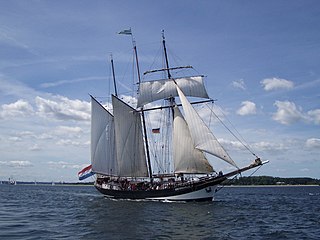
Oosterschelde is a three-masted schooner from the Netherlands, built in 1918. She is the largest restored Dutch freightship and the only remaining Dutch three-masted topsail schooner. Her home port is Rotterdam.

Cape Horn is the southernmost headland of the Tierra del Fuego archipelago of southern Chile, and is located on the small Hornos Island. Although not the most southerly point of South America, Cape Horn marks the northern boundary of the Drake Passage and marks where the Atlantic and Pacific Oceans meet.

Herzogin Cecilie was a German-built four-mast barque (windjammer), named after German Crown Princess Duchess Cecilie of Mecklenburg-Schwerin (1886–1954), spouse of Crown Prince Wilhelm of Prussia (1882–1951). She sailed under German, French and Finnish flags.

Grain Race or The Great Grain Race was the informal name for the annual windjammer sailing season generally from South Australia's grain ports on Spencer Gulf to Lizard Point, Cornwall on the southwesternmost coast of the United Kingdom, or to specific ports. A good, fast passage Australia-to-England via Cape Horn was considered anything under 100 days.

Priwall was a four-masted steel-hulled barque with royal sails over double top and topgallant sails. The windjammer was ordered by the F. Laeisz shipping company of Hamburg and launched at the Blohm & Voss yard, Hamburg, on 23 June 1917. After delays arising from a shortage of materials during and after First World War, she was completed on 6 March 1920. Priwall was used on the nitrate trade route to the west coast of South America; she also made several voyages from South Australia's Spencer Gulf grain ports to Europe. Her code Letters were RWLN; in 1934 they were changed to DIRQ.
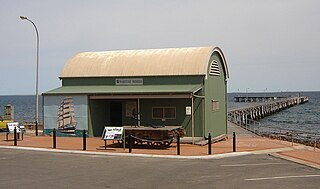
The Port Victoria Maritime Museum is a maritime museum located in South Australia, located on the west coast of the Yorke Peninsula in Port Victoria. It is housed in a cargo shed which was brought out from the United Kingdom in kit form in 1877 and was completed in January 1878. Household goods for the early settlers in the town and surrounding farmlands were brought by steamers from Port Adelaide and stored in the cargo shed until the settlers’ homes were completed.

The Åland Maritime Museum is a museum in Mariehamn in Åland, Finland. It is located in the western part of the town on the sea on Hamngatan, about 1 km (0.62 mi) at the other end of Storagatan. Along with Ålands Museum, it is the most important museum in the islands and a monument to the history of Åland as holder of the world's largest fleet of wooden sailing ships. The foremost exhibit is a four-masted barque named Pommern, built in Glasgow in 1903, which is anchored behind the museum. The museum designed building is built like a ship's prow cutting into the land. It has been called the "kitsch museum of fishing and maritime commerce."

HMS Endeavour replica is a replica of HMS Endeavour, the bark commanded by Lieutenant James Cook when he charted New Zealand and the eastern coast of Australia.

Hougomont was the name of a four-masted steel barque built in Greenock, Scotland in 1897 by Scotts Shipbuilding & Engineering Co. In 1924 she was purchased by Gustav Erikson's shipping company in Mariehamn, Åland, Finland. She was used for transport and schooling ship for young sailors until 1932 when a squall completely broke her rig on the Southern Ocean and she was sunk as breakwater near the town of Stenhouse Bay in South Australia. ' Hougomont had a crew of 24 men. The name "Hougomont" is derived from Château d'Hougoumont where the Battle of Waterloo was fought. While seaworthy she sailed to Peru, Florida, Canada, Australia, England, Ireland, and Sweden among other destinations. She had two sister ships, Nivelle and Archibald Russell.

